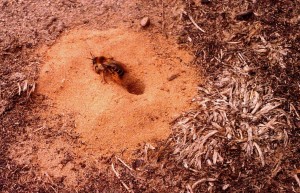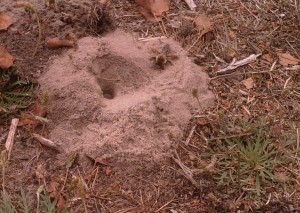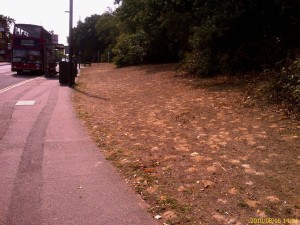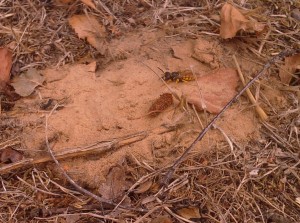Ever wondered about those hundreds of little piles of sand that appear along the Erith Road margin of Bursted Woods, by the bus stop, every summer? Well, they’re back once again, and they’re the uncommon London species Hairy-legged Mining Bee (Dasypoda hirtipes) .
According to the Essex Field Club website : ‘This mining bee occurs in southern Britain, and whilst still reasonably widespread and locally common on southern coastal dunes, it has declined significantly inland (Falk, 1991a). ……. The bee is remarkable for the female’s very large pollen brushes on the hind tibia. The species will form nesting aggregations in bare or sparsely vegetated sandy or other friable soils and females collect pollen exclusively from composites (Asteraceae) especially yellow flowered species such as Ox-tongues Picris spp. and Ragworts Senecio spp.’
Bees, Wasps and Ants of Kent (Kent Field Club, 2009) has few records for it in west Kent or Bexley, and these are mainly along the Thames corridor.

Three-quarter rear view of female showing dense hairs on hind legs, used as ‘paddles’ to excavate sand from nest holes. (Photo: Chris Rose).

Female ‘paddling’ backwards to push more sand out of and away from the nest hole (Photo: Chris Rose)
Also present (in 2010 at least) has been the Beewolf (Philanthus triangulum), which until fairly recently was quite rare in the UK, but is one of those species that has become far more widespread of late. It preys mainly on Honeybees, and I have yet to determine whether it also takes Dasypoda. It may just have happened to take a fancy to the same sandy bank for nesting purposes. It is one of those species that paralyses prey, in this case by stinging it, then deposits it in its nest for its larvae to feed on later.
Interestingly, this photo of Barnehurst parade, dating from around 1965, seems to suggest that the Dasypoda had taken up residence here at least 50 years ago, although it’s not conclusive without taking a magnifying glass to a good quality print:
http://images.francisfrith.com/c10/450/27/B667056.jpg


